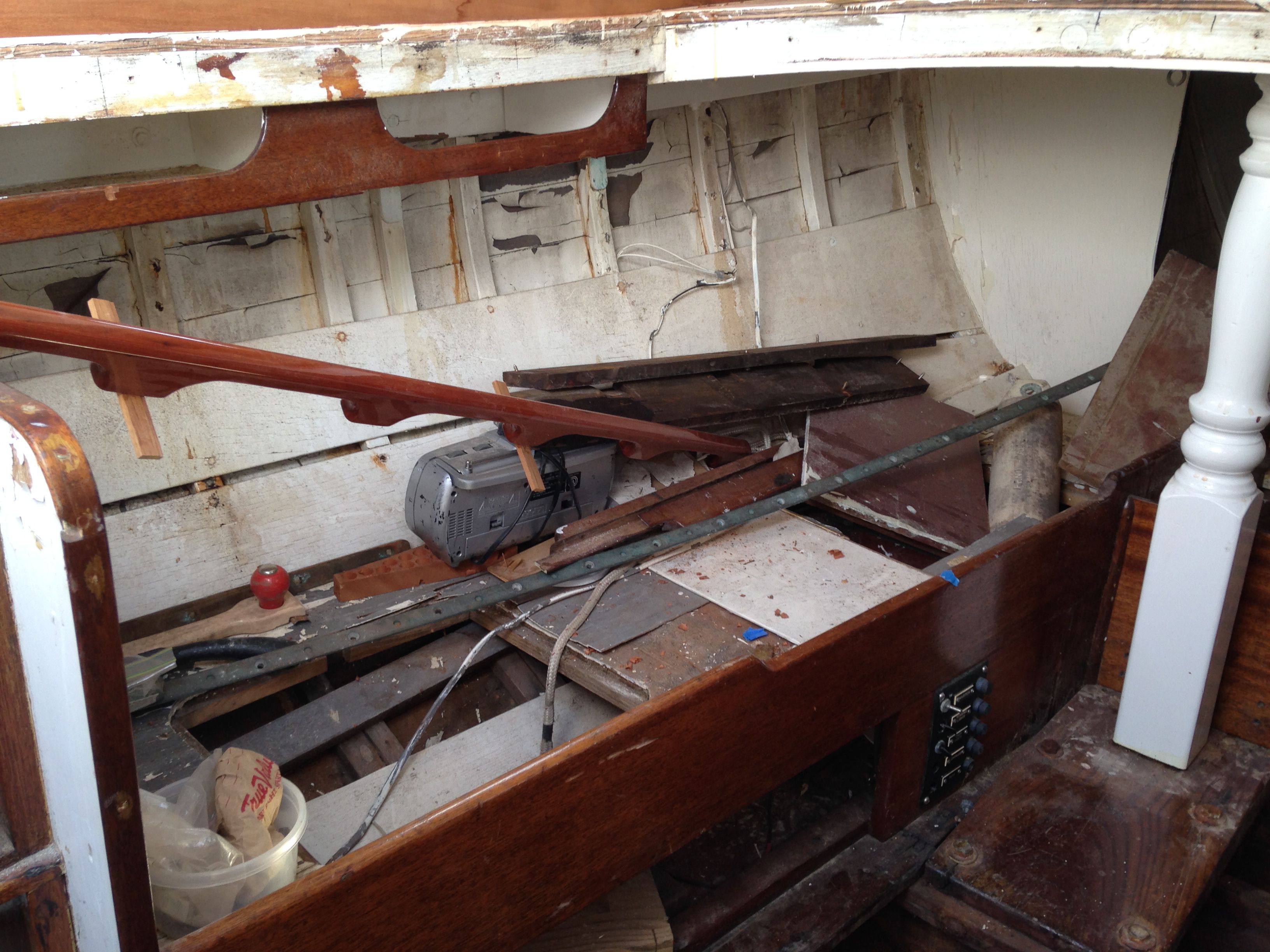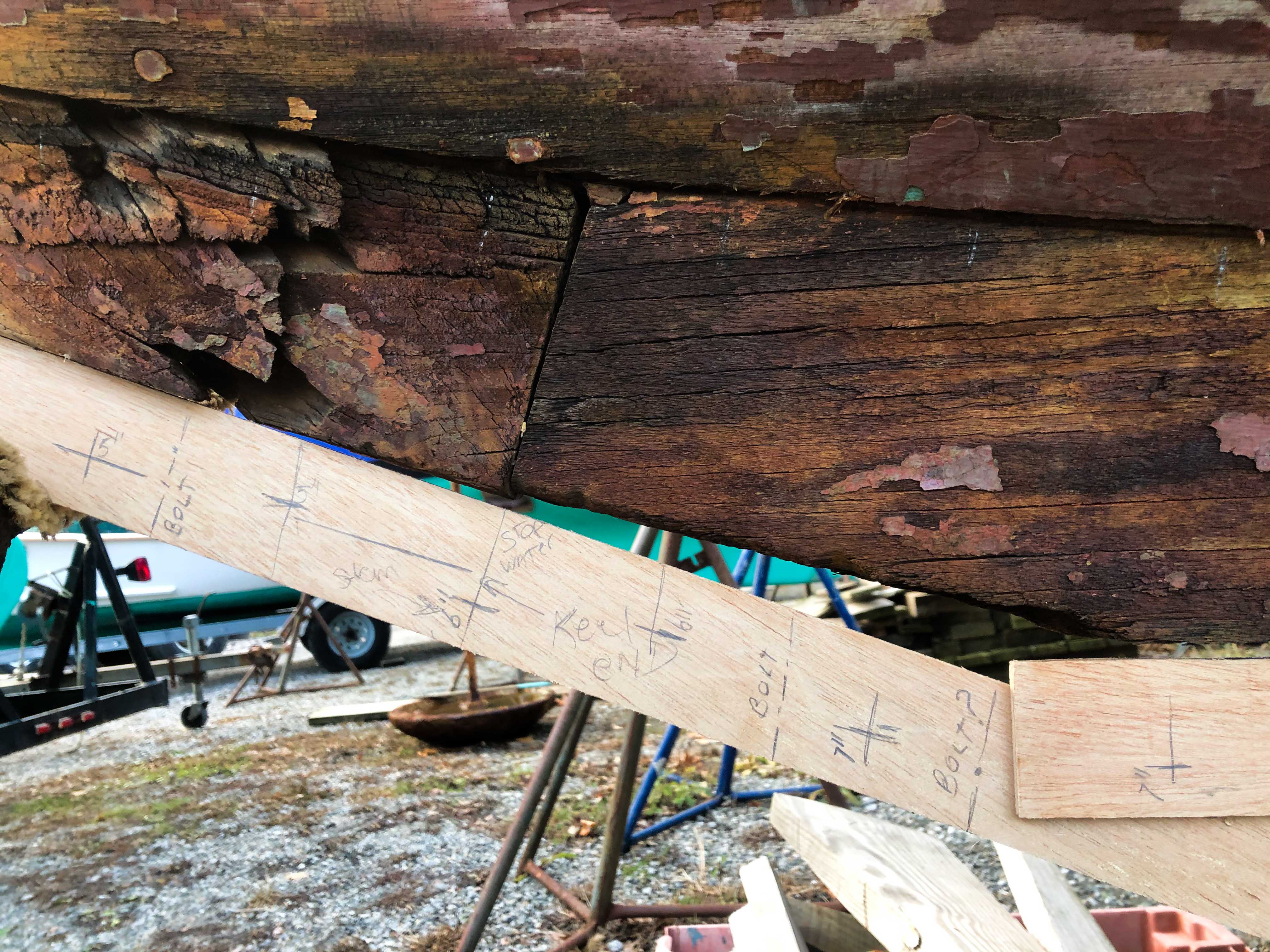

Here I am before the realization of what I am about to embark upon. The smile is the ignorance of not knowing what is coming.
After getting most of the iron fastenings out of the topsides, refastening I was feeling pretty good about the project.
Then I went inside:


As you can see in the above pictures the interior was a mess. So I went about removing the plywood under the bunks. The plywood had de-laminated to the point where I was pulling up the wood by hand. No tools needed. Once I removed the plywood and interior I saw the terror inducing sight; The frames were toast. Everything below the waterline literally pulled apart by hand.
Now the big choice became "do I proceed to reframe and basically rebuild the whole boat or cut it up and throw it away"?
Since by this time I've had about 6 years into the project, it seemed like a waste to stop and trash everything I've done.b onward I go.
Here are some pictures of what I found: Click on the pictures for a caption.
As you can see the framing was shot. The floors, the fastenings were all practically gone. So out it came. These pictures were taken so I can remember what it is supposed to look like when I put it all back together.
Since I replaced the deck, there was no way to steam bend new frames into the boat. Maybe it was possible but since I hadn't had much experience steam bending I decided to go with laminating oak frames.
Removing the old frames required removing the fastenings I just installed. Once the metal was removed I was able to pry the frame away from the planking. It became easier since the frame had almost no strength left and often would break. The more intact part was above the water line. Since I inserted dowels into the frames to get the fastenings to hold, I now had to cut these with a hacksaw blade on a handle. Wasn't very hard. I loosened or removed the bolts holding the stringer and shelf against the frame. Then when the frame was loose I was able to pry it down from the deck and remove.
With the frame gone, I made up my pattern on the space the frame was to get the curve. After cleaning up paint, decayed wood from the planking, I coated the planking, the holes inside and out with CPES.
Installing the new frame wasn't all that difficult. After cutting the bevel at the deck and as close as I could get at the keel, I was able to slip it up under the stringer and using my foot and my body braced I was able to slide it up into place.
Here is the process I used to get it done.
These pictures were taken in 2015 and 2016
The years of 2017 and 2018 were used to replicate the replacement of the frames going forward. Finally we get to the bulkhead. As with all the plywood on the boat, it was delaminating and needed to be replaced. With the bulkhead removed I also had access to the frame attaching the bulkhead to the hull as well as the entire bow. This is important since the front of the keel needs to be fixed.
Here is the removal of the bulkhead:
The main issue with the bulkhead floor is that the chock holding the stem to the keel was butted up against the floor. Poor drainage caused the rot. I removed the bulkhead November 2018.
The real work of reconstruction comes next.
For years I've been keeping my eye on the front of the keel. From the outside there was a few deep canyons where wood had fallen out of the stem where it meets the keel. Here's a picture:

The left side of the picture shows the damage. To get at the stem end I needed to remove the chock holding the stem to the keel.
Before starting on this journey, I documented the shape of the bow. The picture above shows the pattern I'm transferring the data to. The crosses with 7" next to it are the points and direction where the planking rabbit is. These marks are every 6 inches. Also noted are the locations of the bolts, end of ballast and where the two pieces meet.
Here are the pattern pictures and notations November 2019: Click on the pictures for captions.
Now that the pattern has been made, I have the shape and locations of what is about to be taken apart. Now to move to the inside of the boat. The first order of business is to remove the bolts connecting the chock to the sem and keel. Here are a couple of pictures of the fasteners I took out:
Not an awful lot left of the iron bolt. The rest were a little of a challenge but nothing serious.
The pictures below show the chock removed and the carnage if what was underneath.
Winter of 2020 was demolition time for the keel and stem.
With a good scarph joint cut and since it was mid January I soaked the scarph with Cold Weather CPES for a few days, one application per day until the wood was done absorbing.
With this done I started working on the replacement keel end. Seeing this was January in Connecticut the temperature hovers up to about freezing during the day. Epoxy doesn't like to cure in cold temps. The general rule of thumb is the catalyst reaction doubles in time every twenty degrees of change in temperature. I use Smith & Co. Oak and Teak Epoxy Glue. Although this glue will fully cure at these temperatures, I wanted to speed things up so I built a gluing oven. Using foam "Project Panels" (basically 2' X 4' insulative foam) from the local construction superstore, I built a box big enough to cover the glue-up.
At this point it is mid March 2020. Covid shutdown in full swing. I have more time to devote to this project. A boatyard in the winter is a form of quarantine so I just kept on going. The next step was to fabricate a new chock. The old one was a great template. I transferred the outline to sheet paper and transferred to the laminated wood for cutting. Since we already have covered the lamination process, I'll skip the pictures on that. These pictures are of the transferring of the shape.
The timeline on this work is a little confusing by looking at the pictures. After removing the bulkhead (see Reframing the Situation) I removed the chock. Then I cut the front of the keel. I rebuilt the front of the keel. Using the chock in place on the stem attached with rod stock in stead of fasteners and clamps, I was able to get the shape of the new keel piece. I planed an fabricated the new stem piece while leaving the stem intact. Then I fabricated the new chock. During this time I was replacing the bow frames since the hole was open. Here are the pictures from April to May 2020:
June of 2020 and the framing is done. Now it's time to glue the new keel end to the keel. First the bolts holding the whole thing together need to be drilled. then the front of the ballast needed to be added to since the iron had crumbled and became ragged. I used the new keel piece as the form. I didn't document this with pictures. Basically i removed the crumbling iron, buffed what I could with a wheel, treated it with a phosphorus treatment that turns iron oxide (rust) into a stable surface to glue to. I used carton tape (the clear stuff) on the keel end and the chock as a barrier so the epoxy wouldn't stick to the wood. I mixed up Fill-It and applied a thick coat to the end of the keel. Fill-It is a pre thickened epoxy that is like wood when it cures. It's the white stuff in all of the pictures. Finally I bolted the keel end in place and let it cure. During this time I also replaced the porch columns on my house slowing the progress on the boat. Here are the pictures of the assembly:
With the dry fit of the new pieces done, the rabbet needs to be cut into the new stem. Without this the planking will not have anything to screw into. The picture on the left is the reconstruction of the two pieces of the old stem. On the right is the stem on its back looking closely the rabbet can be seen. I simply measured from one to the other to create points to join using a fairing batten. Then with wood chisels and a rabbet plane, cut the rabbet.
Finishing up the bow reconstruction was basically gluing the new stem to the old stem. I again protected the chock with carton sealing tape to prevent gluing the whole thing together. After the Oak & Teak epoxy had set, I dissassembled the chock, removed the tape, coated everythig with CPES (clear penetrating epoxy sealer. The next time Icame down I coated everthing with red lead paint to preserve adainst decay. By now its the end of September.
On to the next project: New toe rail
